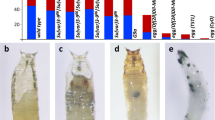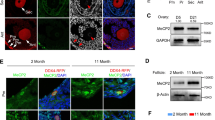Abstract
Genetic studies have shown that aberrant activation of p53 signaling leads to embryonic lethality. Maintenance of a fine balance of the p53 protein level is critical for normal development. Previously, we have reported that Jmjd5, a member of the Jumonji C (JmjC) family, regulates embryonic cell proliferation through the control of Cdkn1a expression. Since Cdkn1a is the representative p53-regulated gene, we have examined whether the expression of other p53 target genes is coincidentally upregulated with Cdkn1a in Jmjd5-deficient embryos. The expression of a subset of p53-regulated genes was increased in both Jmjd5 hypomorphic mouse embryonic fibroblasts (MEFs) and Jmjd5-deficient embryos at embryonic day 8.25 without the induced expression of Trp53. Intercrossing of Jmjd5-deficient mice with Trp53 knockout mice showed that the growth defect of Jmjd5 mutant cells was significantly recovered under a Trp53 null genetic background. Chromatin immunoprecipitation analysis in Jmjd5 hypomorphic MEFs indicated the increased recruitment of p53 at several p53 target gene loci, such as Cdkn1a, Pmaip1, and Mdm2. These results suggest that Jmjd5 is involved in the transcriptional regulation of a subset of p53-regulated genes, possibly through the control of p53 recruitment at the gene loci. In Jmjd5-deficient embryos, the enhanced recruitment of p53 might result in the abnormal activation of p53 signaling leading to embryonic lethality.






Similar content being viewed by others

References
Beckerman R, Prives C (2010) Transcriptional regulation by p53. Cold Spring Harb Perspect Biol 2:a000935
Dai C, Gu W (2010) p53 post-translational modification: deregulated in tumorigenesis. Trends Mol Med 16:528–536
Del Rizzo PA, Krishnan S, Trievel RC (2012) Crystal structure and functional analysis of JMJD5 indicate an alternate specificity and function. Mol Cell Biol 32:4044–4052
Deng C, Zhang P, Harper JW, Elledge SJ, Leder P (1995) Mice lacking p21CIP1/WAF1 undergo normal development, but are defective in G1 checkpoint control. Cell 82:675–684
Donehower LA, Lozano G (2009) 20 years studying p53 functions in genetically engineered mice. Nat Rev Cancer 9:831–841
el-Deiry WS, Tokino T, Velculescu VE, Levy DB, Parsons R, Trent JM, Lin D, Mercer WE, Kinzler KW, Vogelstein B (1993) WAF1, a potential mediator of p53 tumor suppression. Cell 75:817–825
el-Deiry WS, Tokino T, Waldman T, Oliner JD, Velculescu VE, Burrell M, Hill DE, Healy E, Rees JL, Hamilton SR et al (1995) Topological control of p21WAF1/CIP1 expression in normal and neoplastic tissues. Cancer Res 55:2910–2919
Frank AK, Leu JI, Zhou Y, Devarajan K, Nedelko T, Klein-Szanto A, Hollstein M, Murphy ME (2011) The codon 72 polymorphism of p53 regulates interaction with NF-{kappa}B and transactivation of genes involved in immunity and inflammation. Mol Cell Biol 31:1201–1213
Ghebranious N, Donehower LA (1998) Mouse models in tumor suppression. Oncogene 17:3385–3400
Hsia DA, Tepper CG, Pochampalli MR, Hsia EY, Izumiya C, Huerta SB, Wright ME, Chen HW, Kung HJ, Izumiya Y (2010) KDM8, a H3K36me2 histone demethylase that acts in the cyclin A1 coding region to regulate cancer cell proliferation. Proc Natl Acad Sci U S A 107:9671–9676
Huang J, Sengupta R, Espejo AB, Lee MG, Dorsey JA, Richter M, Opravil S, Shiekhattar R, Bedford MT, Jenuwein T, Berger SL (2007) p53 is regulated by the lysine demethylase LSD1. Nature 449:105–108
Huang X, Zhang L, Qi H, Shao J, Shen J (2013) Identification and functional implication of nuclear localization signals in the N-terminal domain of JMJD5. Biochimie 95:2114–2122
Huang X, Zhang S, Qi H, Wang Z, Chen HW, Shao J, Shen J (2015) JMJD5 interacts with p53 and negatively regulates p53 function in control of cell cycle and proliferation. Biochim Biophys Acta 1853(10 Pt A):2286–2295, doi: 10.1016/j.bbamcr.2015.05.026
Ishimura A, Minehata K, Terashima M, Kondoh G, Hara T, Suzuki T (2012) Jmjd5, an H3K36me2 histone demethylase, modulates embryonic cell proliferation through the regulation of Cdkn1a expression. Development 139:749–759
Jones MA, Covington MF, DiTacchio L, Vollmers C, Panda S, Harmer SL (2010) Jumonji domain protein JMJD5 functions in both the plant and human circadian systems. Proc Natl Acad Sci U S A 107:21623–21628
Jones SN, Roe AE, Donehower LA, Bradley A (1995) Rescue of embryonic lethality in Mdm2-deficient mice by absence of p53. Nature 378:206–208
Kim TD, Oh S, Shin S, Janknecht R (2012a) Regulation of tumor suppressor p53 and HCT116 cell physiology by histone demethylase JMJD2D/KDM4D. PLoS One 7:e34618
Kim TD, Shin S, Berry WL, Oh S, Janknecht R (2012b) The JMJD2A demethylase regulates apoptosis and proliferation in colon cancer cells. J Cell Biochem 113:1368–1376
Kimura H, Hayashi-Takanaka Y, Goto Y, Takizawa N, Nozaki N (2008) The organization of histone H3 modifications as revealed by a panel of specific monoclonal antibodies. Cell Struct Funct 33:61–73
Klose RJ, Kallin EM, Zhang Y (2006) JmjC-domain-containing proteins and histone demethylation. Nat Rev Genet 7:715–727
Lee KH, Park JW, Sung HS, Choi YJ, Kim WH, Lee HS, Chung HJ, Shin HW, Cho CH, Kim TY, Li SH, Youn HD, Kim SJ, Chun YS (2014) PHF2 histone demethylase acts as a tumor suppressor in association with p53 in cancer. Oncogene 34:2897–2909
Levine AJ (1997) p53, the cellular gatekeeper for growth and division. Cell 88:323–331
Levine AJ, Oren M (2009) The first 30 years of p53: growing ever more complex. Nat Rev Cancer 9:749–758
Marouco D, Garabadgiu AV, Melino G, Barlev NA (2013) Lysine-specific modifications of p53: a matter of life and death? Oncotarget 4:1556–1571
Montes de Oca Luna R, Wagner DS, Lozano G (1995) Rescue of early embryonic lethality in mdm2-deficient mice by deletion of p53. Nature 378:203–206
Nagy A, Gertsenstein M, Vintersten K, Behringer R (2003) Manipulating the mouse embryo: a laboratory manual, 3rd edn. Cold Spring Harbor Laboratory, New York, pp 371–373
Oda E, Ohki R, Murasawa H, Nemoto J, Shibue T, Yamashita T, Tokino T, Taniguchi T, Tanaka N (2000) Noxa, a BH3-only member of the Bcl-2 family and candidate mediator of p53-induced apoptosis. Science 288:1053–1058
Oh S, Janknecht R (2012) Histone demethylase JMJD5 is essential for embryonic development. Biochem Biophys Res Commun 420:61–65
Riley T, Sontag E, Chen P, Levine A (2008) Transcriptional control of human p53-regulated genes. Nat Rev Mol Cell Biol 9:402–412
Schmid P, Lorenz A, Hameister H, Montenarh M (1991) Expression of p53 during mouse embryogenesis. Development 113:857–865
Sola S, Xavier JM, Santos DM, Aranha MM, Morgado AL, Jepsen K, Rodrigues CM (2011) p53 interaction with JMJD3 results in its nuclear distribution during mouse neural stem cell differentiation. PLoS One 6:e18421
Tsai WW, Nguyen TT, Shi Y, Barton MC (2008) p53-targeted LSD1 functions in repression of chromatin structure and transcription in vivo. Mol Cell Biol 28:5139–5146
Tsukada T, Tomooka Y, Takai S, Ueda Y, Nishikawa S, Yagi T, Tokunaga T, Takeda N, Suda Y, Abe S et al (1993) Enhanced proliferative potential in culture of cells from p53-deficient mice. Oncogene 8:3313–3322
Vousden KH, Prives C (2009) Blinded by the light: the growing complexity of p53. Cell 137:413–431
Wang H, Zhou X, Wu M, Wang C, Zhang X, Tao Y, Chen N, Zang J (2013) Structure of the JmjC-domain-containing protein JMJD5. Acta Crystallogr D Biol Crystallogr 69:1911–1920
Wang HJ, Hsieh YJ, Cheng WC, Lin CP, Lin YS, Yang SF, Chen CC, Izumiya Y, Yu JS, Kung HJ, Wang WC (2014) JMJD5 regulates PKM2 nuclear translocation and reprograms HIF-1alpha-mediated glucose metabolism. Proc Natl Acad Sci U S A 111:279–284
Williams K, Christensen J, Rappsilber J, Nielsen AL, Johansen JV, Helin K (2014) The histone lysine demethylase JMJD3/KDM6B is recruited to p53 bound promoters and enhancer elements in a p53 dependent manner. PLoS One 9:e96545
Wu X, Bayle JH, Olson D, Levine AJ (1993) The p53-mdm-2 autoregulatory feedback loop. Genes Dev 7:1126–1132
Youn MY, Yokoyama A, Fujiyama-Nakamura S, Ohtake F, Minehata K, Yasuda H, Suzuki T, Kato S, Imai Y (2012) JMJD5, a Jumonji C (JmjC) domain-containing protein, negatively regulates osteoclastogenesis by facilitating NFATc1 protein degradation. J Biol Chem 287:12994–13004
Zhu H, Hu S, Baker J (2014) JMJD5 regulates cell cycle and pluripotency in human embryonic stem cells. Stem Cells 32:2098–2110
Acknowledgments
We thank Dr A. Hirao (Kanazawa University, Japan) for providing Cdkn1a- and Trp53-deficient mice, Dr. T. Nakamura (Kansai Medical University, Japan) for providing the pEF6/FLAG-His6 plasmid, Dr. M. Yoshida (Japanese Foundation for Cancer Research, Japan) for providing the HA-p53-expression vector, and Dr. H. Kimura (Tokyo Institute of Technology, Japan) for providing the anti-H3K36me2 antibody.
Author information
Authors and Affiliations
Corresponding author
Additional information
This work was supported by Grants-in-Aid for Scientific Research C (Research Project numbers: 25460266 to A.I. and 15 K08263 to T.S.) from the Ministry of Education, Culture, Sports, Science, and Technology of Japan.
Electronic supplementary material
Below is the link to the electronic supplementary material.
Fig. S1
Immunofluorescence with anti-single-strand DNA antibody to visualize apoptotic cells (red) in (a, b) wild-type and (c, d) Jmjd5Δ/Δ embryos at E8.5. DAPI (blue) was used for nuclear staining. Bars 100 μm (GIF 213 kb)
Rights and permissions
About this article
Cite this article
Ishimura, A., Terashima, M., Tange, S. et al. Jmjd5 functions as a regulator of p53 signaling during mouse embryogenesis. Cell Tissue Res 363, 723–733 (2016). https://doi.org/10.1007/s00441-015-2276-7
Received:
Accepted:
Published:
Issue Date:
DOI: https://doi.org/10.1007/s00441-015-2276-7



